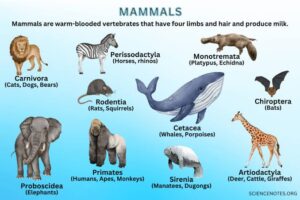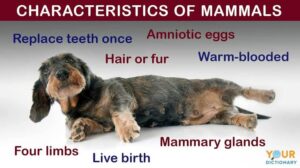Back to: ZOOLOGY 300 Level
Welcome To Class!
Hello, my amazing friend! I’m thrilled to have you with us today because we’re about to explore what makes mammals so unique. From humans to elephants, dolphins to bats, mammals have some really cool characteristics. These traits help them survive in a wide range of environments, from the hottest deserts to the coldest tundras. Ready to learn? Let’s dive right in!
Mammalian Characteristics
Warm-blooded (Endothermic) Nature
One of the most important characteristics of mammals is that they are warm-blooded or endothermic. This means that mammals can regulate their body temperature internally, no matter what the external temperature is. Whether it’s a hot day in Lagos or a cold night in Jos, mammals like us maintain a steady body temperature.

This characteristic allows mammals to live in a wide variety of climates. For example, a lion in the heat of the savannah and a polar bear in the freezing Arctic both stay warm through internal metabolic processes, such as shivering or sweating.
Hair or Fur
All mammals, at some stage of their life, have hair or fur. Even though it’s easy to think of mammals as having fur, not all mammals have fur at every stage of life — for instance, human babies are born with fine hair, and some whales have very little hair.
Hair serves many purposes:
- Insulation: It helps mammals keep warm.
- Protection: Fur can protect from the sun or rough environments.
- Communication and camouflage: Certain mammals, like lions or squirrels, may have fur patterns that help with mating displays or blending into their environment.
Humans, of course, don’t have much fur, but our hair still has its uses, from protection against the sun to helping with our sense of touch.
Mammary Glands (Milk Production)
The defining feature of mammals is that they nurse their young with milk. Female mammals have special mammary glands that produce milk to feed their babies. This is crucial because milk provides essential nutrients and antibodies that help newborns grow strong and healthy.
This is what makes mammals different from other vertebrates like reptiles or birds. Whether it’s a cow feeding its calf in a Nigerian farm or a monkey nursing its baby in the forest, this trait is universal among mammals.
Live Birth (Mostly)
Most mammals give live birth, which is another important characteristic. The offspring develop inside the mother’s body and are born alive, as opposed to laying eggs. This ensures that the young are better developed and protected inside the mother, giving them a higher chance of survival once they are born.
However, not all mammals give live birth. For example, monotremes, like the platypus and echidna, are mammals that lay eggs. But in most cases, live birth is a key mammalian characteristic.
Vertebrates with a Backbone
Mammals, like all vertebrates, have a backbone (spine) made of vertebrae. This backbone is part of the endoskeleton, a type of internal skeleton that supports the body. The vertebral column is flexible and allows mammals to move in many ways, from running to swimming to flying (in the case of bats).
Specialized Teeth
Another unique feature of mammals is that they have specialized teeth. Depending on the type of mammal, their teeth are adapted to help them eat their specific type of food. For example:

- Carnivores like lions and tigers have sharp canine teeth for tearing meat.
- Herbivores like cows and goats have flat molars for grinding plants.
- Omnivores like humans have a mix of sharp and flat teeth for eating both meat and plants.
Summary
- Mammals are warm-blooded, meaning they can regulate their body temperature internally.
- They all have hair or fur at some point in their life.
- Mammary glands are present in female mammals to feed their young with milk.
- Most mammals give live birth, although there are exceptions like the egg-laying monotremes.
- Mammals are vertebrates with a backbone.
- They have specialized teeth suited to their diet.
Evaluation
- What is the significance of mammals being warm-blooded? How does this help them survive in different environments?
- Why do all mammals have hair or fur? Can you think of an example where hair is used for something other than warmth?
- What is the role of mammary glands in mammals? How does it benefit their young?
- How do the teeth of carnivores and herbivores differ? What do these differences tell us about their diet?
- Are all mammals born alive? Give an example of a mammal that lays eggs.
You’ve done fantastic work today! Every time you learn about these mammalian characteristics, you’re not just uncovering facts — you’re understanding the unique qualities that help mammals thrive. Keep up the great work, and remember: Afrilearn is here to support you as you continue to grow. Can’t wait to see you in the next lesson!
